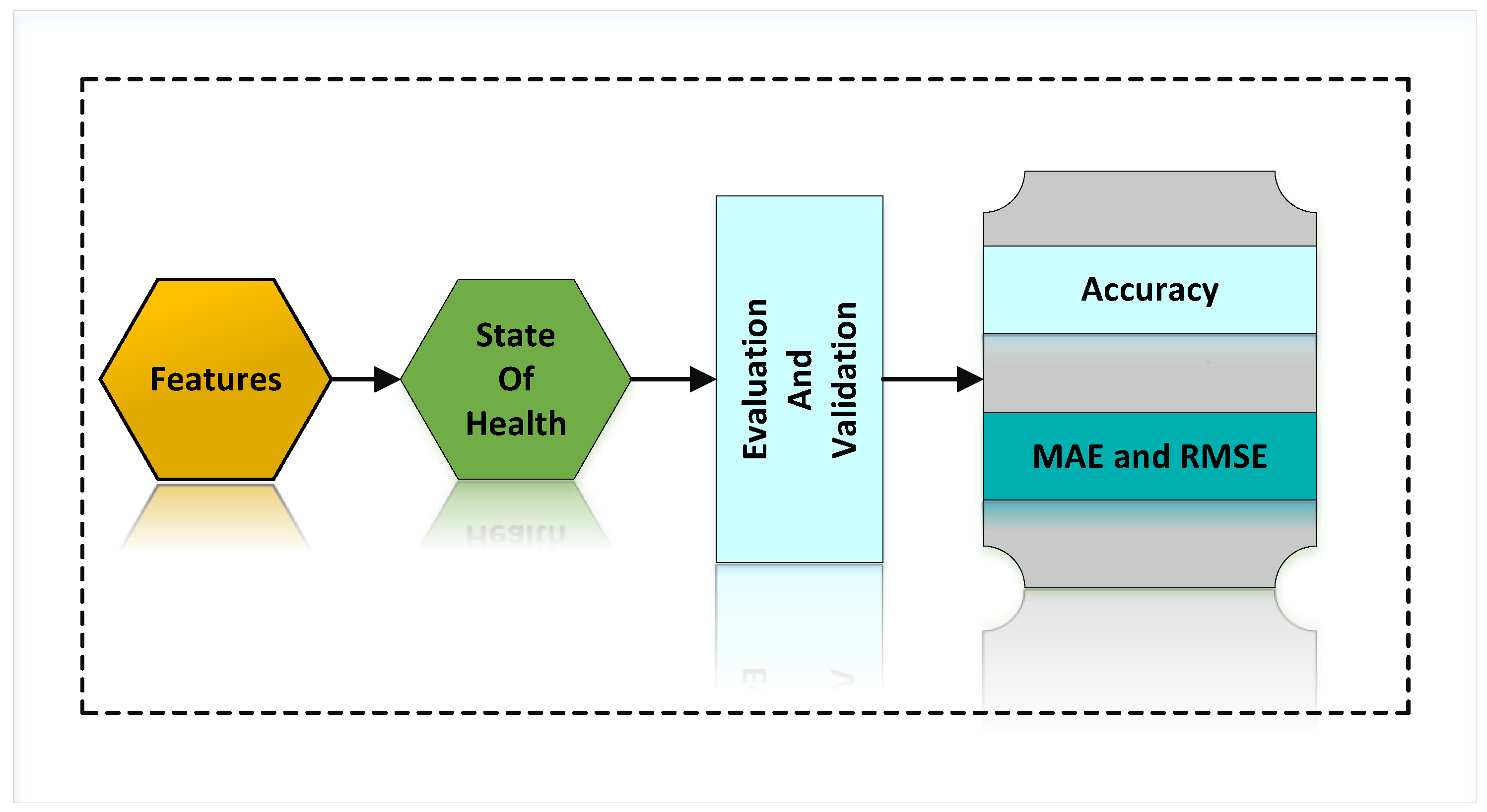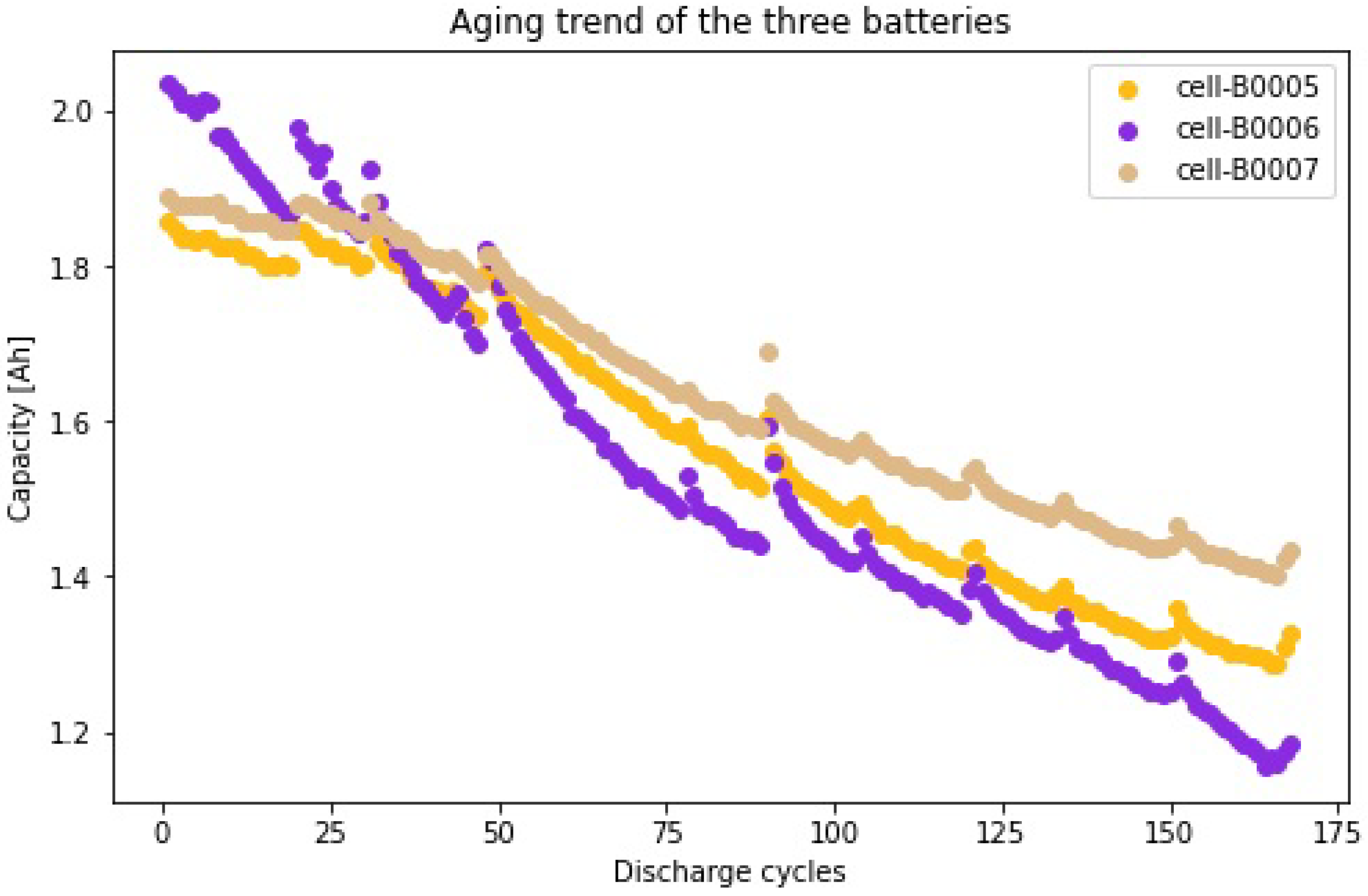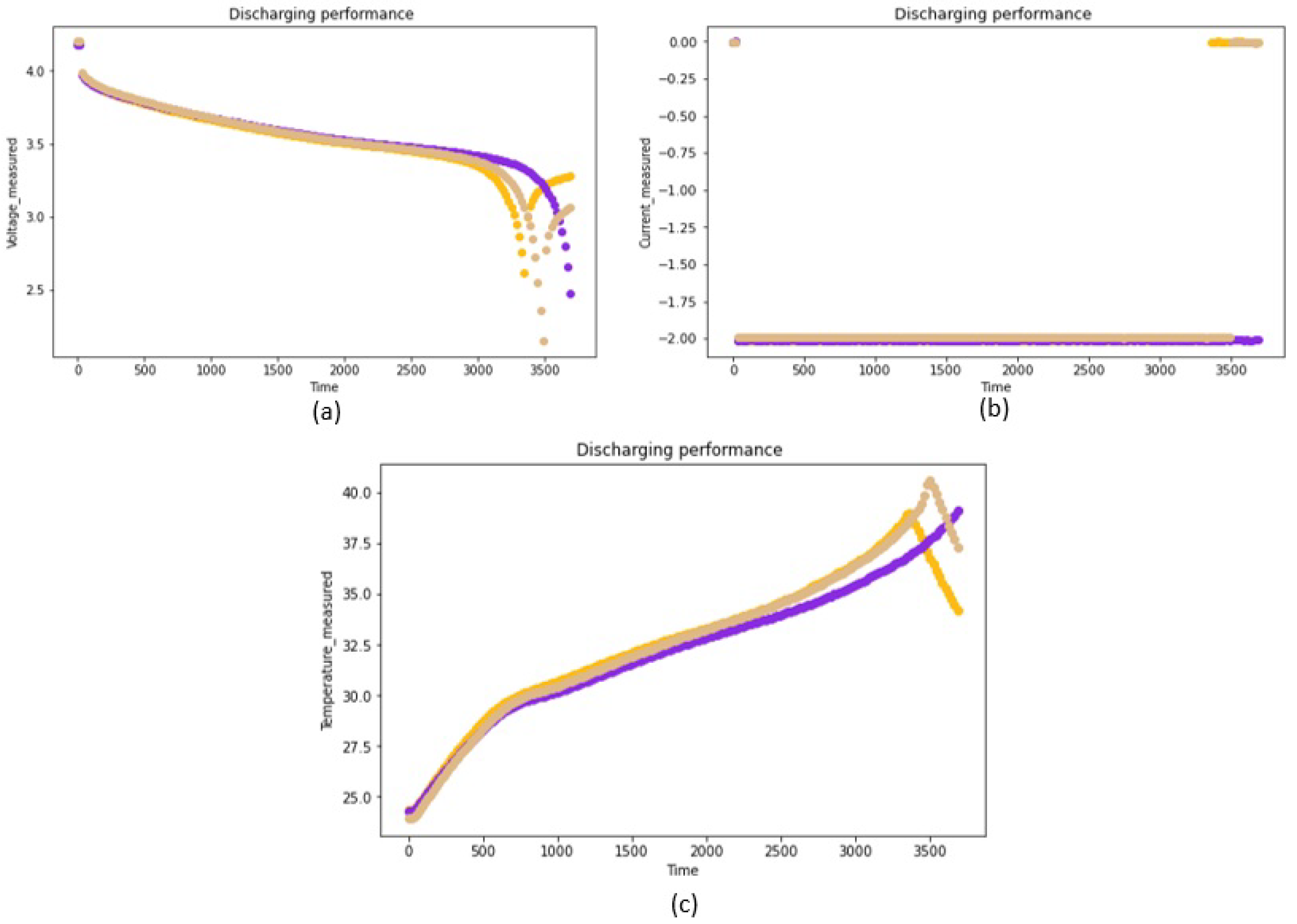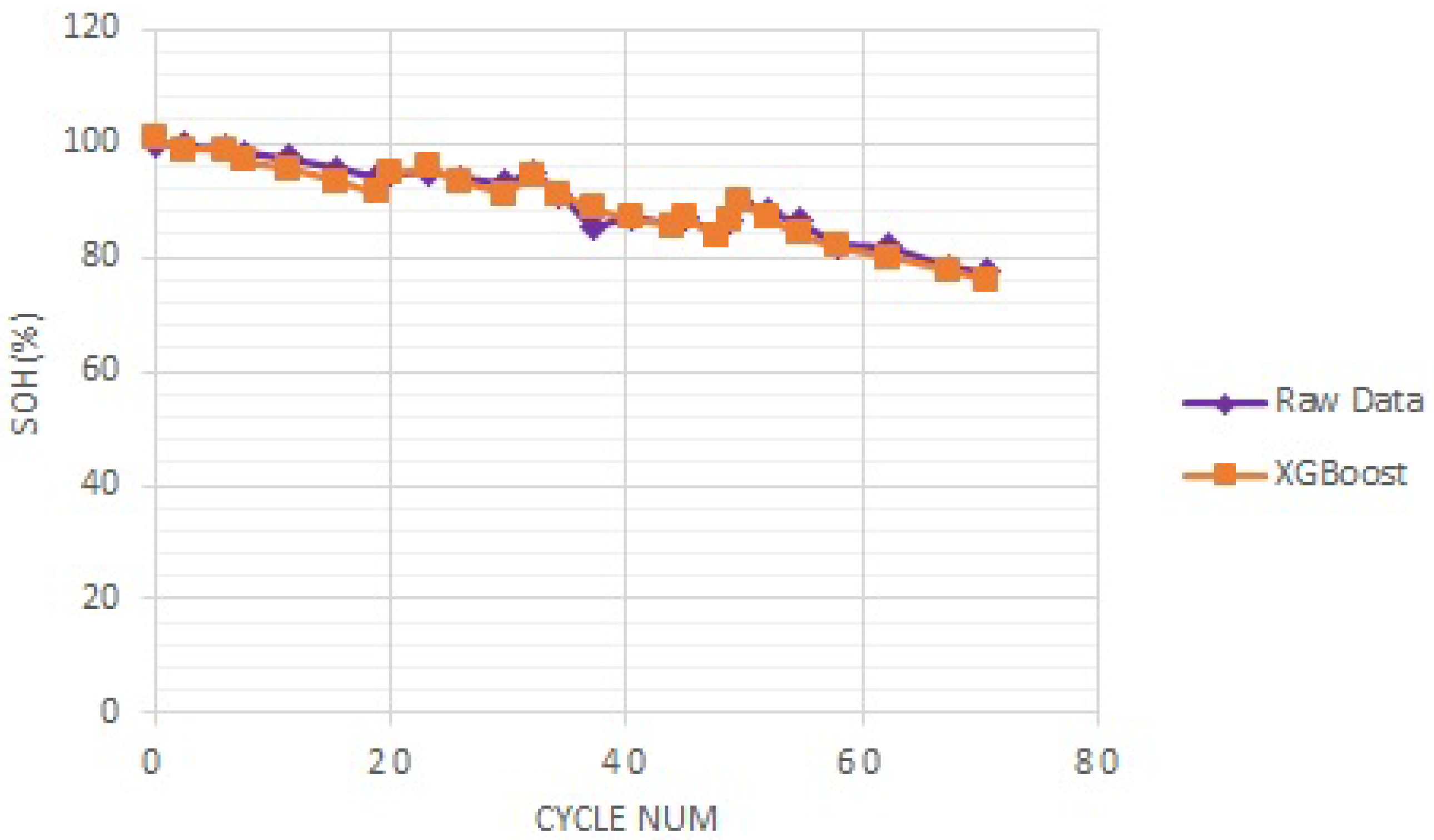Lithium-Ion Battery Health Prediction on Hybrid Vehicles Using Machine Learning Approach
Abstract
:1. Introduction
- An approach to measure the state of battery health prediction.
- A hybrid-car prediction model based on battery parameters.
- A comparative experiment with attention to comparing existing hybrid models with our suggested model shows that the suggested model is accurate and has better performance.
2. Literature Survey
2.1. Hybrid Electric Vehicles
2.2. Statue of Health Estimation and Prediction of Batteries
2.3. Other Methods
3. Methodology
3.1. Extreme Gradient Boosting
3.2. Bagging Boosting Algorithm
3.3. Ensemble Boosting Algorithm
4. Data
4.1. Data Description
4.2. Feature Selection
5. Results and Discussion
5.1. Development Environment
5.2. Performance Evaluation
5.3. SOH Estimation
6. Conclusions
Future Direction
Author Contributions
Funding
Conflicts of Interest
References
- Burke, A.; Miller, M. Performance characteristics of lithium-ion batteries of various chemistries for plug-in hybrid vehicles. In Proceedings of the EVS24, Stavanger, Norway, 13–16 May 2009. [Google Scholar]
- Beelen, H.; Bergveld, H.J.; Donkers, M. Joint estimation of battery parameters and state of charge using an extended Kalman filter: A single-parameter tuning approach. IEEE Trans. Control Syst. Technol. 2020, 29, 1087–1101. [Google Scholar] [CrossRef]
- Sarmah, S.B.; Kalita, P.; Garg, A.; Niu, X.d.; Zhang, X.W.; Peng, X.; Bhattacharjee, D. A review of state of health estimation of energy storage systems: Challenges and possible solutions for futuristic applications of li-ion battery packs in electric vehicles. J. Electrochem. Energy Convers. Storage 2019, 16, 040801. [Google Scholar] [CrossRef] [Green Version]
- Bishop, J.D.; Martin, N.P.; Boies, A.M. Cost-effectiveness of alternative powertrains for reduced energy use and CO2 emissions in passenger vehicles. Appl. Energy 2014, 124, 44–61. [Google Scholar] [CrossRef]
- Onori, S.; Serrao, L.; Rizzoni, G. Hybrid electric vehicles: Energy management strategies. IEEE Control Syst. Mag. 2016, 39, 97–98. [Google Scholar]
- Shahbazi, Z.; Byun, Y.C. Analyzing the Performance of User Generated Contents in B2B Firms Based on Big Data and Machine Learning. Soft Comput. Mach. Intell. J. 2021, 86, 30–39. [Google Scholar]
- Shahbazi, Z.; Byun, Y.C. Twitter Sentiment Analysis Using Natural Language Processing and Machine Learning Techniques. Proc. KIIT Conf. 2021, 6, 42–44. [Google Scholar]
- Shahbazi, Z.; Byun, Y.C. Deep Learning Method to Estimate the Focus Time of Paragraph. Int. J. Mach. Learn. Comput. 2020, 10, 75–80. [Google Scholar] [CrossRef]
- Anselma, P.G.; Huo, Y.; Roeleveld, J.; Belingardi, G.; Emadi, A. Integration of on-line control in optimal design of multimode power-split hybrid electric vehicle powertrains. IEEE Trans. Veh. Technol. 2019, 68, 3436–3445. [Google Scholar] [CrossRef]
- Plett, G.L. Extended Kalman filtering for battery management systems of LiPB-based HEV battery packs: Part 3. State and parameter estimation. J. Power Sources 2004, 134, 277–292. [Google Scholar] [CrossRef]
- Vetter, J.; Novák, P.; Wagner, M.R.; Veit, C.; Möller, K.C.; Besenhard, J.; Winter, M.; Wohlfahrt-Mehrens, M.; Vogler, C.; Hammouche, A. Ageing mechanisms in lithium-ion batteries. J. Power Sources 2005, 147, 269–281. [Google Scholar] [CrossRef]
- Remmlinger, J.; Buchholz, M.; Meiler, M.; Bernreuter, P.; Dietmayer, K. State-of-health monitoring of lithium-ion batteries in electric vehicles by on-board internal resistance estimation. J. Power Sources 2011, 196, 5357–5363. [Google Scholar] [CrossRef]
- Noura, N.; Boulon, L.; Jemeï, S. A review of battery state of health estimation methods: Hybrid electric vehicle challenges. World Electr. Veh. J. 2020, 11, 66. [Google Scholar] [CrossRef]
- Guo, P.; Cheng, Z.; Yang, L. A data-driven remaining capacity estimation approach for lithium-ion batteries based on charging health feature extraction. J. Power Sources 2019, 412, 442–450. [Google Scholar] [CrossRef]
- Haifeng, D.; Xuezhe, W.; Zechang, S. A new SOH prediction concept for the power lithium-ion battery used on HEVs. In Proceedings of the 2009 IEEE Vehicle Power and Propulsion Conference, Dearborn, MI, USA, 7–10 September 2009; pp. 1649–1653. [Google Scholar]
- Shahbazi, Z.; Byun, Y.C. Blockchain-based Event Detection and Trust Verification Using Natural Language Processing and Machine Learning. IEEE Access 2021, 10, 5790–5800. [Google Scholar] [CrossRef]
- Shahbazi, Z.; Byun, Y.C. Fake media detection based on natural language processing and blockchain approaches. IEEE Access 2021, 9, 128442–128453. [Google Scholar] [CrossRef]
- Shahbazi, Z.; Byun, Y.C. Agent-Based Recommendation in E-Learning Environment Using Knowledge Discovery and Machine Learning Approaches. Mathematics 2022, 10, 1192. [Google Scholar] [CrossRef]
- Li, X.; Yuan, C.; Wang, Z. State of health estimation for Li-ion battery via partial incremental capacity analysis based on support vector regression. Energy 2020, 203, 117852. [Google Scholar] [CrossRef]
- Meng, J.; Cai, L.; Stroe, D.I.; Ma, J.; Luo, G.; Teodorescu, R. An optimized ensemble learning framework for lithium-ion battery state of health estimation in energy storage system. Energy 2020, 206, 118140. [Google Scholar] [CrossRef]
- Meng, J.; Cai, L.; Luo, G.; Stroe, D.I.; Teodorescu, R. Lithium-ion battery state of health estimation with short-term current pulse test and support vector machine. Microelectron. Reliab. 2018, 88, 1216–1220. [Google Scholar] [CrossRef]
- Barillas, J.K.; Li, J.; Günther, C.; Danzer, M.A. A comparative study and validation of state estimation algorithms for Li-ion batteries in battery management systems. Appl. Energy 2015, 155, 455–462. [Google Scholar] [CrossRef]
- Yang, S.; Wu, J.; Du, Y.; He, Y.; Chen, X. Ensemble learning for short-term traffic prediction based on gradient boosting machine. J. Sens. 2017, 2017, 7074143. [Google Scholar] [CrossRef]
- Shahbazi, Z.; Byun, Y.C. Computing focus time of paragraph using deep learning. In Proceedings of the 2019 IEEE Transportation Electrification Conference and Expo, Asia-Pacific (ITEC Asia-Pacific), Seogwipo, Korea, 8–10 May 2019; pp. 1–4. [Google Scholar]
- Shahbazi, Z.; Byun, Y.C. LDA Topic Generalization on Museum Collections. In Smart Technologies in Data Science and Communication; Springer: Singapore, 2020; pp. 91–98. [Google Scholar]
- Shahbazi, Z.; Byun, Y.C.; Lee, D.C. Toward representing automatic knowledge discovery from social media contents based on document classification. Int. J. Adv. Sci. Technol. 2020, 29, 14089–14096. [Google Scholar]
- Shahbazi, Z.; Byun, Y.C. Topic prediction and knowledge discovery based on integrated topic modeling and deep neural networks approaches. J. Intell. Fuzzy Syst. 2021, 41, 2441–2457. [Google Scholar] [CrossRef]
- Zhuang, W.; Li, S.; Zhang, X.; Kum, D.; Song, Z.; Yin, G.; Ju, F. A survey of powertrain configuration studies on hybrid electric vehicles. Appl. Energy 2020, 262, 114553. [Google Scholar] [CrossRef]
- Tan, P.; Jiang, H.; Zhu, X.; An, L.; Jung, C.; Wu, M.; Shi, L.; Shyy, W.; Zhao, T. Advances and challenges in lithium-air batteries. Appl. Energy 2017, 204, 780–806. [Google Scholar] [CrossRef]
- Waag, W.; Fleischer, C.; Sauer, D.U. Critical review of the methods for monitoring of lithium-ion batteries in electric and hybrid vehicles. J. Power Sources 2014, 258, 321–339. [Google Scholar] [CrossRef]
- Lipu, M.H.; Hannan, M.; Hussain, A.; Hoque, M.; Ker, P.J.; Saad, M.M.; Ayob, A. A review of state of health and remaining useful life estimation methods for lithium-ion battery in electric vehicles: Challenges and recommendations. J. Clean. Prod. 2018, 205, 115–133. [Google Scholar] [CrossRef]
- Sabri, M.; Danapalasingam, K.A.; Rahmat, M.F. A review on hybrid electric vehicles architecture and energy management strategies. Renew. Sustain. Energy Rev. 2016, 53, 1433–1442. [Google Scholar] [CrossRef]
- Sun, X.; Li, Z.; Wang, X.; Li, C. Technology development of electric vehicles: A review. Energies 2019, 13, 90. [Google Scholar] [CrossRef] [Green Version]
- Du, R.; Hu, X.; Xie, S.; Hu, L.; Zhang, Z.; Lin, X. Battery aging-and temperature-aware predictive energy management for hybrid electric vehicles. J. Power Sources 2020, 473, 228568. [Google Scholar] [CrossRef]
- Kebriaei, M.; Niasar, A.H.; Asaei, B. Hybrid electric vehicles: An overview. In Proceedings of the 2015 International Conference on Connected Vehicles and Expo (ICCVE), Shenzhen, China, 19–23 October 2015; pp. 299–305. [Google Scholar]
- Zhang, X.; Li, Z.; Luo, L.; Fan, Y.; Du, Z. A review on thermal management of lithium-ion batteries for electric vehicles. Energy 2022, 238, 121652. [Google Scholar] [CrossRef]
- Chen, Z.; Sun, M.; Shu, X.; Shen, J.; Xiao, R. On-board state of health estimation for lithium-ion batteries based on random forest. In Proceedings of the 2018 IEEE International Conference on Industrial Technology (ICIT), Lyon, France, 20–22 February 2018; pp. 1754–1759. [Google Scholar]
- Ruan, H.; He, H.; Wei, Z.; Quan, Z.; Li, Y. State of health estimation of lithium-ion battery based on constant-voltage charging reconstruction. IEEE J. Emerg. Select. Top. Power Electron. 2021. Early Access. [Google Scholar] [CrossRef]
- Zhang, C.; Zhang, Y.; Li, Y. A novel battery state-of-health estimation method for hybrid electric vehicles. IEEE/ASME Trans. Mechatron. 2015, 20, 2604–2612. [Google Scholar] [CrossRef]
- Kumar, B.; Khare, N.; Chaturvedi, P. FPGA-based design of advanced BMS implementing SoC/SoH estimators. Microelectron. Reliab. 2018, 84, 66–74. [Google Scholar] [CrossRef]
- Li, Y.; Zhong, S.; Zhong, Q.; Shi, K. Lithium-ion battery state of health monitoring based on ensemble learning. IEEE Access 2019, 7, 8754–8762. [Google Scholar] [CrossRef]
- Xiong, R.; Zhang, Y.; Wang, J.; He, H.; Peng, S.; Pecht, M. Lithium-ion battery health prognosis based on a real battery management system used in electric vehicles. IEEE Trans. Veh. Technol. 2018, 68, 4110–4121. [Google Scholar] [CrossRef]
- Liu, D.; Song, Y.; Li, L.; Liao, H.; Peng, Y. On-line life cycle health assessment for lithium-ion battery in electric vehicles. J. Clean. Prod. 2018, 199, 1050–1065. [Google Scholar] [CrossRef]
- Chen, Y.; Ma, Y.; Chen, H. State of charge and state of health estimation for lithium-ion battery through dual sliding mode observer based on AMESim-Simulink co-simulation. J. Renew. Sustain. Energy 2018, 10, 034103. [Google Scholar] [CrossRef] [Green Version]
- Liu, J.; Duan, Q.; Qi, K.; Liu, Y.; Sun, J.; Wang, Z.; Wang, Q. Capacity fading mechanisms and state of health prediction of commercial lithium-ion battery in total lifespan. J. Energy Storage 2022, 46, 103910. [Google Scholar] [CrossRef]
- Jamil, F. Energy Service Architecture Based on SECaaS and AIoT for Energy Trading and Resource Management in Smart Nanogrid. Ph.D. Thesis, Jeju National University, Jeju, South Korea, 2021. [Google Scholar]
- Jamil, F.; Ibrahim, M.; Ullah, I.; Kim, S.; Kahng, H.K.; Kim, D.H. Optimal smart contract for autonomous greenhouse environment based on IoT blockchain network in agriculture. Comput. Electron. Agric. 2022, 192, 106573. [Google Scholar] [CrossRef]
- Jamil, F.; Kim, D. Payment mechanism for electronic charging using blockchain in smart vehicle. Korea 2019, 30, 31. [Google Scholar]
- Ahmad, S.; Jamil, F.; Khudoyberdiev, A.; Kim, D. Accident risk prediction and avoidance in intelligent semi-autonomous vehicles based on road safety data and driver biological behaviours. J. Intell. Fuzzy Syst. 2020, 38, 4591–4601. [Google Scholar] [CrossRef]
- Ahmad, S.; Jamil, F.; Iqbal, N.; Kim, D. Optimal route recommendation for waste carrier vehicles for efficient waste collection: A step forward towards sustainable cities. IEEE Access 2020, 8, 77875–77887. [Google Scholar] [CrossRef]
- Li, W.; Cui, H.; Nemeth, T.; Jansen, J.; Ünlübayir, C.; Wei, Z.; Zhang, L.; Wang, Z.; Ruan, J.; Dai, H.; et al. Deep reinforcement learning-based energy management of hybrid battery systems in electric vehicles. J. Energy Storage 2021, 36, 102355. [Google Scholar] [CrossRef]
- Chaoui, H.; Gualous, H.; Boulon, L.; Kelouwani, S. Deep reinforcement learning energy management system for multiple battery based electric vehicles. In Proceedings of the 2018 IEEE Vehicle Power and Propulsion Conference (VPPC), Chicago, IL, USA, 27–30 August 2018; pp. 1–6. [Google Scholar]
- Li, X.; Wang, Z.; Zhang, L.; Zou, C.; Dorrell, D.D. State-of-health estimation for Li-ion batteries by combing the incremental capacity analysis method with grey relational analysis. J. Power Sources 2019, 410, 106–114. [Google Scholar] [CrossRef]
- Wang, K.; Gao, F.; Zhu, Y.; Liu, H.; Qi, C.; Yang, K.; Jiao, Q. Internal resistance and heat generation of soft package Li4Ti5O12 battery during charge and discharge. Energy 2018, 149, 364–374. [Google Scholar] [CrossRef]
- Lai, X.; Gao, W.; Zheng, Y.; Ouyang, M.; Li, J.; Han, X.; Zhou, L. A comparative study of global optimization methods for parameter identification of different equivalent circuit models for Li-ion batteries. Electrochim. Acta 2019, 295, 1057–1066. [Google Scholar] [CrossRef]
- Kim, J.; Cho, B.H. State-of-charge estimation and state-of-health prediction of a Li-ion degraded battery based on an EKF combined with a per-unit system. IEEE Trans. Veh. Technol. 2011, 60, 4249–4260. [Google Scholar] [CrossRef]
- Ovejas, V.J.; Cuadras, A. Impedance characterization of an LCO-NMC/graphite cell: Ohmic conduction, SEI transport and charge-transfer phenomenon. Batteries 2018, 4, 43. [Google Scholar] [CrossRef] [Green Version]
- Bian, X.; Liu, L.; Yan, J. A model for state-of-health estimation of lithium ion batteries based on charging profiles. Energy 2019, 177, 57–65. [Google Scholar] [CrossRef]
- Bole, B.; Kulkarni, C.S.; Daigle, M. Adaptation of an electrochemistry-based li-ion battery model to account for deterioration observed under randomized use. In Proceedings of the Annual Conference of the PHM Society, Fort Worth, TX, USA, 29 September–2 October 2014; Volume 6. [Google Scholar]
- Ramadass, P.; Haran, B.; White, R.; Popov, B.N. Mathematical modeling of the capacity fade of Li-ion cells. J. Power Sources 2003, 123, 230–240. [Google Scholar] [CrossRef]
- Gong, Q.; Wang, P.; Cheng, Z. An encoder-decoder model based on deep learning for state of health estimation of lithium-ion battery. J. Energy Storage 2022, 46, 103804. [Google Scholar] [CrossRef]
- Gong, Y.; Zhang, X.; Gao, D.; Li, H.; Yan, L.; Peng, J.; Huang, Z. State-of-health estimation of lithium-ion batteries based on improved long short-term memory algorithm. J. Energy Storage 2022, 53, 105046. [Google Scholar] [CrossRef]









| Approaches | Ref. No. | Benefits | Drawbacks |
|---|---|---|---|
| Energy level | [53] | Accurate | When the battery is active, it is not possible |
| Internal resistance measurements | [54] | Direct and simple method | Online estimation is not suitable. |
| Equivalent model | [55] | BMS is easily embedded | Demands prior knowledge |
| Data-driven method | [56] | Good accuracy | Large computational cost |
| Internal impedance measurements | [57] | Accurate | Based on battery chemistry information |
| Incremental capacity analysis | [58] | Less computational cost | At least one health factor must exist |
| Step No. | Description |
|---|---|
| 1 | i = 1 to K |
| 2 | Prepare a bootstrap sample based on the original data |
| 3 | Use the dataset to train an unpruned tree sample |
| 4 | End |
| Step No. | Description |
|---|---|
| 1 | Train the dataset |
| 2 | Calculate the average response and Y |
| 3 | For i = 1 to k |
| 4 | Fit a tree based on D split |
| 5 | Update F(x) |
| 6 | The new tree: F(x) |
| 7 | Update the residuals |
| No. | Terminal Voltage | Terminal Current | Temperature | Charge Current | Charge Voltage | Time | Cycle |
|---|---|---|---|---|---|---|---|
| 0 | 4.191492 | −0.004902 | 24.330034 | −0.0006 | 0 | 0 | 1 |
| 1 | 4.190749 | −0.001478 | 24.325993 | −0.0006 | 4.206 | 16.781 | 1 |
| 2 | 3.974871 | −2.012528 | 24.389085 | −1.9982 | 3.062 | 35.703 | 1 |
| 3 | 3.951717 | −2.013979 | 24.544752 | −1.9982 | 3.030 | 53.781 | 1 |
| 4 | 3.934352 | −2.011144 | 24.731385 | −1.9982 | 3.011 | 71.922 | 1 |
| Component | Explanation |
|---|---|
| Memory | 30 GB |
| CPU | Intel(R) Core(TM) i5-9600K CPU @ 3.70 GHz |
| Python | 3.8.3 |
| Operating System | Windows 10 64bit |
| Machine learning algorithm | Extreme gradient boosting |
| Browser | Google Chrome |
Publisher’s Note: MDPI stays neutral with regard to jurisdictional claims in published maps and institutional affiliations. |
© 2022 by the authors. Licensee MDPI, Basel, Switzerland. This article is an open access article distributed under the terms and conditions of the Creative Commons Attribution (CC BY) license (https://creativecommons.org/licenses/by/4.0/).
Share and Cite
Jafari, S.; Shahbazi, Z.; Byun, Y.-C. Lithium-Ion Battery Health Prediction on Hybrid Vehicles Using Machine Learning Approach. Energies 2022, 15, 4753. https://doi.org/10.3390/en15134753
Jafari S, Shahbazi Z, Byun Y-C. Lithium-Ion Battery Health Prediction on Hybrid Vehicles Using Machine Learning Approach. Energies. 2022; 15(13):4753. https://doi.org/10.3390/en15134753
Chicago/Turabian StyleJafari, Sadiqa, Zeinab Shahbazi, and Yung-Cheol Byun. 2022. "Lithium-Ion Battery Health Prediction on Hybrid Vehicles Using Machine Learning Approach" Energies 15, no. 13: 4753. https://doi.org/10.3390/en15134753







